So, I’m about to say something that might sound surprising coming from somebody who has been going around with the box art from The Dig as his avatar for the last 15 years. There’s good reason for that; not only is it an extremely striking piece of artwork, but there’s a lot about The Dig that I absolutely adore. I love the theme. I love the music. I love the artwork and the animation, and above all I love the sheer sense of atmosphere that The Dig conveys at all times. It’s the first one of these games where, for once, I don’t resent having to watch my character walk from one side of a screen to the other because that gives me a bit of time to soak in the sounds and visuals of its mysterious alien world. The Dig gets a hell of a lot right, for all that it makes some weird choices in terms of its interface; it would work extremely well as a visual novel, or perhaps as the 1995 equivalent of a walking simulator.
But as a classically-styled point-and-click adventure game with puzzles? I’m not so sure about that.
It’s interesting to compare The Dig to Full Throttle, since they both came out in the same year. Full Throttle started development in 1993 and was released in 1995, giving it a two-year development cycle — this is a little on the short side by modern standards1, but it’s still around twice the development time prior LucasArts adventure games received because it had a much larger budget and was consciously searching for ways to revitalise a genre that was increasingly seen as being too niche to attain the kinds of sales numbers that contemporary hits such as Myst and Doom were raking in2. The Dig, on the other hand, started development in 1989. It was in development for six years — an eternity by early ‘90s standards — and was one of the first high-profile examples of a game being stuck in development hell thanks to some rather unfortunate pre-release publicity telling players that The Dig would be Coming Soon… in 1992. The Dig underwent several reboots and four different game directors before finally coming out in November 1995, seven months after Full Throttle. Given that, it’s something of a miracle that The Dig is as good as it is; I can think of many other examples of games with similar development trajectories where the final product ended up being a buggy, borderline unplayable mess. However, this is also why there’s a significant amount of evolutionary divergence between The Dig and Full Throttle, and it’s why The Dig feels like the older game despite coming out seven months after Full Throttle, since it branched off from the family tree long before Full Throttle even got started.
If you read the piece I wrote on Full Throttle, you’ll know that I don’t wholly consider that a bad thing. The Dig is, at least, much more recognisable as a LucasArts adventure game, with a quasi-open structure that allows for exploration and experimentation on the player’s terms instead of rudely pushing them down a linear path from one set-piece encounter to the next. The Dig opens with a short introduction sequence set in space, which functions as the game’s tutorial; there’s a giant asteroid headed towards Earth, and since this is the 1990s the obvious solution to giant asteroids headed towards Earth is to send a team of astronauts to blow it up with nukes3. Once the fireworks have died down a three-person team descends into the newly-uncovered interior of the asteroid and discovers that it’s actually a gigantic alien spaceship, and after rather unwisely pushing some buttons they shouldn’t have the three astronauts are rudely whisked away to the aliens’ home planet. This wouldn’t be an immediately bad thing since it seems NASA suspected something like this might happen and staffed the mission with specialists for talking to aliens, except it turns out that all of the aliens vanished millenia ago and the astronauts are now stranded in the middle of their decaying ruins with no way to get home.
This starts The Dig proper: exploring the alien ruins, figuring out what happened to all of the aliens and their technology, and hopefully finding some way of getting back to Earth in the process. The alien spaceship has deposited the three astronauts onto a central island platform surrounded by five rocky spires, which in turn are surrounded by nothing but ocean as far as the eye can see; the astronaut team pretty quickly splits up to “cover more ground” (have these people never seen a horror movie?) and you’re left in control of Boston Low, the expedition commander. Boston opens up access from the hub island to the spires one at a time, gradually piecing together how the alien technology works and what each spire was used for. Once an area is opened up it remains open, and you’re free to backtrack to your heart’s content if you think you missed something; there’s only a few puzzles that actively require this since under the hood The Dig is still quite linear in the way that all adventure games ultimately are — puzzle A yields the item needed to solve puzzle B which opens the door leading to puzzle C, and so on — but it’s much better at camouflaging this linear path than Full Throttle was. It might be a facade, but the feeling of freedom that this open structure confers is not, and for The Dig it’s absolutely crucial. You need to feel like you’re exploring on your own terms in The Dig; you need to be able to buy into the fiction that you are playing an archeologist on a dead alien world uncovering long-lost secrets, because otherwise there’s absolutely no way anyone would put up with The Dig’s mind-meltingly obtuse puzzle design.
Now, whether it’s accidental or not I do not know, but there’s definitely a certain amount of playing-to-the-theme that The Dig is doing when it comes to its puzzles. You find a lot of weird alien devices where you have no idea what they’re for, and you have to figure it out by (sigh) trial-and-error — except that actually makes sense here, since that really is the only way you could figure out what a totally alien device would do. There’s a lot of clues shown to you via pictograms and carvings and tablets, and The Dig is a game that rewards taking notes, or at least screenshotting those pictograms for reference later. I have less of an objection to the puzzle design being somewhat illogical in The Dig than I did in, say, Monkey Island 2 or Fate Of Atlantis because, thanks to the core conceit of The Dig, it’s somewhat fitting that you spend your time in its little ring of islands mostly mired in a state of perpetual confusion. It takes the common problem adventure games of this era have, where they’re less about solving puzzles than they are figuring out the workings of a strange, utterly alien intelligence (i.e. the puzzle designer), and flips it into something of a strength because in the case of The Dig that’s the entire premise of the game — that you do have an actual alien intelligence behind it all.
Despite this strength, though, The Dig really does take the piss in a lot of places. Several of its most obtuse puzzles stem from one of its major gimmicks; pretty early on Boston finds a big stash of “life crystals”, which can temporarily restore dead things to life from nothing more than their skeletal remains. These are used in many major puzzle solutions, but it is almost never possible to predict the outcome of using the life crystals in advance. An example: there’s a pair of guard dog skeletons in front of a door. One of them is resurrected by an automated mechanism, preventing you from getting close to it — how then are you to pass through the door? Logic would seem to dictate that if one guard dog is adamantly out for your blood, using a life crystal to resurrect the other guard dog would merely double the size of your original problem. But no, it turns out that the second guard dog hates the first guard dog — presumably had a big promotion nobbled by him several millennia ago, or something — and immediately goes for its throat, smashing it into a wall and extremely conveniently knocking a piece of ceiling masonry loose which crushes them both. You are now free to go through the door. There’s also the infamous turtle bones puzzle, whereby you have to reassemble a turtle skeleton from around fifteen different pieces so that you can bring it back to life… and feed it to the sea monster that’s blocking your passage. Somewhat surprisingly I found the reassembly portion of this puzzle to be far easier than it was the first time I did it (which is when it seared itself into my brain as emblematic of The Dig’s puzzle design) because I know much more about basic skeletal structure now than I did when I was 12; however, there’s an additional step where you have to put a cryptic alien sphere inside the completed skeleton before you use the life crystal on it… because the sphere turns out to be a remote-controlled bomb that you can then use to kill the sea monster. Obviously.
However, The Dig’s crowning moment of absurdity doesn’t involve the life crystals at all, and instead comes towards the end of the game when one of your companions has been abducted and webbed up by a spider-like monster. To rescue her, Boston has to enlist the help of the third member of the expedition to shout at the monster as a distraction, while Boston leisurely walks off screen, down a nice, breezy, sun-dappled canyon, and up a cliffside pathway — his friend at this point is probably monster food, but Boston is remarkably relaxed about it all — to a river above a waterfall. There is a rock here. The rock has no obvious relevance to the problem at hand and is separated from it by at least two screens, but Boston still pushes it over while lampshading just how utterly random this is by saying “At this point, I’m ready to try anything!” It turns out this rock blocks the river, which redirects it to a grate just behind where your companion is being webbed up (how the hell are you supposed to figure this out?), which she can then open to blast the monster out of the cave with a jet of water.
One advantage of having played through all of the LucasArts adventure games in sequence is that I can now see the differing, evolving schools of thought in the puzzle design. There’s one side of the company that’s focusing on the writing and general experience as a shortcut to replayability, and while their puzzles are by no means simple (except in Full Throttle) they’re also comparatively self-contained and streamlined, as they don’t need to rely on puzzle difficulty as a crutch to pad out the playing time; the resulting games may be shorter, but they’re designed to be periodically replayed and hold up much better over time. I can tell just by playing through The Dig that the people who worked on it were from the other side of the company, the one that’s more concerned with trying to outwit their players with increasingly esoteric puzzles; I recognise many of the design tics in The Dig because I’ve seen then a couple of times before in games like Sam & Max and Fate Of Atlantis — it even recycles the “bait and trap an animal in a cage” puzzle from Fate, albeit with an even more fiddly spin on it — and they’re even less tolerable the second or third time around. The Dig didn’t need to be this convoluted, especially when the premise and the art and the animation and the sound are all more than strong enough to support the game on their own; the irony is that while I overall disliked Full Throttle’s too-streamlined puzzle design (I thought the rest of the game wasn’t substantial enough to support it), it would have fit The Dig like a glove. As it is, while not all of The Dig’s puzzles miss quite as badly as the above examples, most of them are painful enough that I regard them as something to suffer through in order to experience the rest of the game, rather than an end in and of themselves.
It’s fortunate, then, that despite The Dig’s tortured development process it came out of it with such a coherent sense of atmosphere. The game is quite obviously a mishmash of several different design iterations — for example, you can talk to the crew of your space shuttle remotely via a little PDA device, except two of them get left behind when Boston and co. are transported away on the alien ship and can’t be contacted outside of the opening twenty minutes of the game, and the geologist Brink stops answering his phone calls shortly afterwards, leaving Boston with just linguist Maggie to talk to (and even she spends most of the game telling him to stop bothering her); I suspect the PDA interface used to be a far more substantial element of the game but got cut down to this sadly truncated form in the final product. The things that consistently land across the entire length of the game, though, are the visuals and the sound and the sense of place. The unnamed alien world you’re stuck on is ancient and abandoned, but it is not dead; as you’re on an island you’re surrounded by the ocean and the constant pounding of waves, and in the distance you can see thunderstorms punctuated by flashes of lightning. There’s plenty of birds and small critters around, and there’s some impressive scenery like the aforementioned waterfall, all of which go towards The Dig feeling substantially livelier than the sterile deserts of Full Throttle — having this wildlife also accentuates the feeling of age and decay surrounding the alien artifacts, as birds make their nests on lightbridge lenses and rodents steal vital components from door controls.
The Dig’s art and animation is mostly superb. I do have a soft spot for it because it’s the very last of the classically-styled LucasArts adventures, with pixel art, the cross cursor and the emblematic LucasArts font that they’ve been using ever since Last Crusade. There’s a few occasions when The Dig does demonstrate why they moved to a higher-definition cartoon style for Curse Of Monkey Island, but even today I find myself impressed by the character design and animation for Boston and his friends; this is one area where they have learned from the mistakes of Fate, which attempted to cram so much detail into the Indy sprite with such a limited range of colours available that it ended up as a confused, indistinct mess. Instead the designs of The Dig are very, very simple: black boots, highly contrasting orange jumpsuit bottoms, one or two colours for the torso (this is the main distinguishing feature between the three astronauts), and that is it. The character sprites can’t be much more than a hundred pixels tall, but thanks to this economy of design they have all of the detail they need to. It helps that the artists are quite literally at the top of their game here (I think you’d struggle to find better pixel art at these resolutions until the indie revival of the late `00s), cramming Boston’s head into a ten-by-ten pixel square, picking out the nose and mouth with just four pixels of shading, giving him three pixels of grey hair at his temples to show he’s an older gentleman — they do a hell of a lot with so little to work with. By contrast the walk and generic interaction animations are silky smooth with more frames than any previous LucasArts game, and it really is a genuine pleasure just to watch Boston walk around trying to uncover the mysteries of the island.
(This does backfire slightly when Boston has to do any kind of one-off custom interaction with an object, as these animations have quite understandably had far less time and effort spent on them and end up looking significantly clunkier by comparison. The Dig also makes the utterly baffling choice to punctuate significant events by portraying them via FMV cartoon sequences, presumably to use up all of that juicy CD storage space that’s suddenly become available, and these look absolutely terrible.)
A running theme through these retrospectives has been the slow evolution of the adventure game interface, and this is another area where The Dig feels like a throwback compared to Full Throttle because it’s using a modified version of the much-hated (by me, anyway) interface from Sam & Max, with an icon-based conversation system and a full-screen inventory containing your action verbs accessible via a single right-click on the mouse. This is understandable when you remember that the final iteration of The Dig started shortly after Sam & Max was released and was helmed by one of the guys behind Sam & Max, but still could have been absolutely disastrous had they not made a few basic yet much-needed changes.
- First, there’s now brief tooltips explaining what each icon in the conversation interface represents is if you hover over them with the cursor — the previously-baffling question mark and exclamation mark icons return, but thanks to the tooltips I now know that the exclamation mark means “Say something profound”. This makes the conversation interface usable, if a little clunky with some conversation options disappearing off the edge of the screen and having to be scrolled to.
- Second, while your action verbs are still technically accessed as items via the inventory (there’s no click-to-cycle option here, thank god), The Dig has cut down the number of action verbs further than any other LucasArts game, to just one: Examine, which is The Dig’s implementation of LOOK AT. Everything else is handled via single left-clicks which are handled appropriately depending on the context — click on a button and you’ll PUSH it, click on a character and you TALK to them, click on an item and you’ll PICK it UP. This is a really nice, streamlined way of handling interactions, although it does come at the cost of some granularity and the only reason The Dig can get away with it is because there are very few characters to interact with.
- And third, the inventory background is now transparent, making the inventory less of a screen-blocking, context-shattering nightmare. I was surprised to discover that Curse’s inventory is basically a full screen switch just like Sam & Max’s, and I think this is one area where it could have learned some valuable lessons from The Dig.
Thus The Dig functions as an interesting look at the other way LucasArts adventure games could have evolved if they’d iterated on Sam & Max’s interface instead of throwing it out wholesale in Full Throttle. These changes worked, too, since unlike Sam & Max The Dig’s interface is perfectly usable; they probably wouldn’t have stuck with the conversation icons but the rest of it is fine and could have been iterated on further in later games. Of course in the historical context it doesn’t matter all that much as LucasArts only made one more 2D adventure game after The Dig; it’s not like we ever got to see if they made the right choice in choosing Full Throttle’s interface as the one to take forward, and as it is the interface choice merely cements The Dig’s status as a weirdly retro (for the time) offshoot from what LucasArts were doing with their other contemporary games.
Finally there’s the sound, and especially the music. The professional-grade voice acting – a big selling point for LucasArts titles ever since Day Of The Tentacle — takes something of a back seat in The Dig because there isn’t really anybody to talk to on the alien planet aside from your two teammates, and as mentioned previously they spend nearly all of their time telling Boston to sod off. As a result the game’s voice acting is mostly Boston talking to himself; Boston is voiced by Robert Patrick, who initially seems well-cast in the role of the sardonic-yet-professional astronaut, but the script he’s given isn’t doing him many favours as Boston is very aware that he’s an adventure game protagonist and keeps making meta references to how stupid the scenarios he is currently facing are (which, let us remember, are entirely in the control of the puzzle designers and so function as an effective critique of just how bad they are at their jobs). These remarks would be very at home in a Monkey Island game, but they’re less welcome in the more grounded sci-fi world of The Dig, especially when this dumb humour is juxtaposed with some pretty gruesome events that occur as the story unfolds4. Still, Boston’s commentary does the job of filling the otherwise dead air of the unnamed alien world, even if his characterisation does tend towards the insufferably smug at times.
The Dig’s music, on the other hand, I’m finding quite difficult to describe. It’s certainly the most unusual soundtrack to be found in a LucasArts adventure game, and arguably any adventure game: all synthesiser tones, some of which connect with one another to form intelligible snippets of music whenever a cutscene or other event happens, but mostly isolated short sequences of notes and sounds that are rhythmically repeated and which are dynamically changed by the iMUSE system as Boston walks around the island. It is not the sort of thing you’d go to Youtube and listen to (although you can if you want) since it makes little sense when shorn of the context of the game5. However, the rather avante garde nature of the soundtrack is arguably what makes The Dig so good at building its atmosphere; it sounds so unusual and ethereal that it sets the perfect tone of otherworldly mystery. The visuals are great, of course, but it’s the music that pulls your brain away from the sillier elements of the puzzles and the story and draws you into that quasi-transcendental feeling like a warm bath.
And when you put the visuals and the music together, well, it’s why I’m willing to forgive The Dig an awful lot that I unhesitatingly damned other games for. I booted it up knowing that it was a heavily flawed game, but I was surprised at how fiddly and annoying a lot of the gameplay was in 2021; the interface may have improved but some of the puzzles were distractingly bad — and not the ones I was expecting from previous playthroughs, either. Despite all that, though, The Dig has a sense of place and purpose that Sam & Max and Fate Of Atlantis and Full Throttle would all kill for. It doesn’t have the humour of Monkey Island or the cleverness of Day Of The Tentacle, but instead brings something quite different to the table: wonder, and a feeling of delving into the truly unknown that still holds up today, for all that The Dig feels quite dated mechanically, even for 1995. It’s something that no subsequent adventure game has managed to recapture for me in quite the same way, and that’s why I treasure The Dig.
- Modern games actually take rather longer than two years to make, but much of that extra time is taken up by a pre-production phase with a much smaller team. ↩
- I wasn’t a big fan of the way it went about this by simplifying the structure and the puzzles into something that looked flashy but was extremely shallow, but it seems the great gaming public of 1995 disagreed with me since Full Throttle sold over a million copies. So by that metric, at least, it was successful. ↩
- In The Dig’s defence the idea here is to use the nukes to deflect the asteroid into a stable orbit, which is at least marginally more plausible than completely obliterating it or splitting it cleanly down the middle. ↩
- The Wikipedia entry says that a previous iteration of The Dig was barely one step removed from being a horror game. This feels very plausible given what made it through into the finished version. ↩
- Although I’m listening to it now and the pieces in the soundtrack are substantially more coherent than the ones in the game, presumably because they haven’t been chopped up into dynamically-changeable snippets of music. ↩

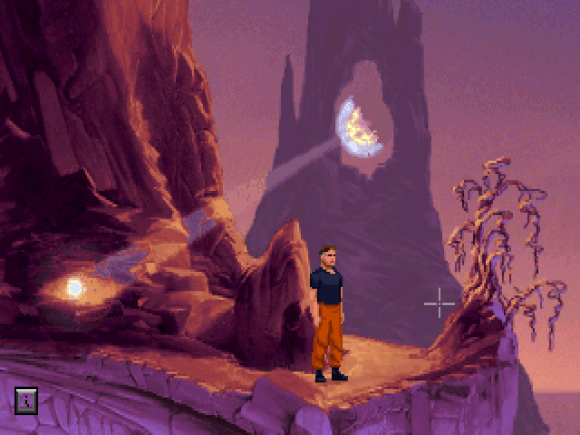
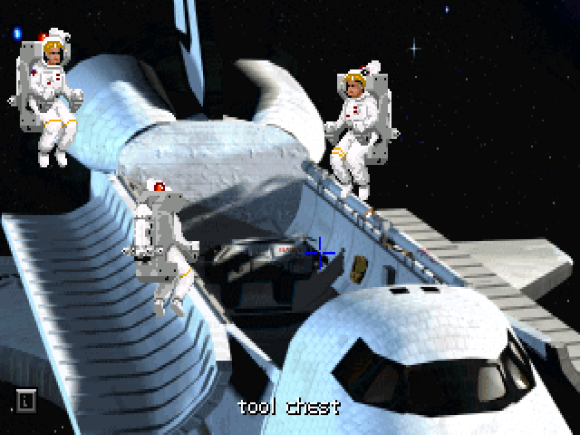
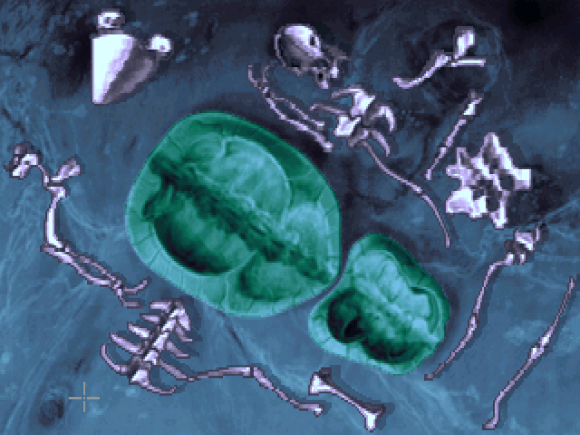
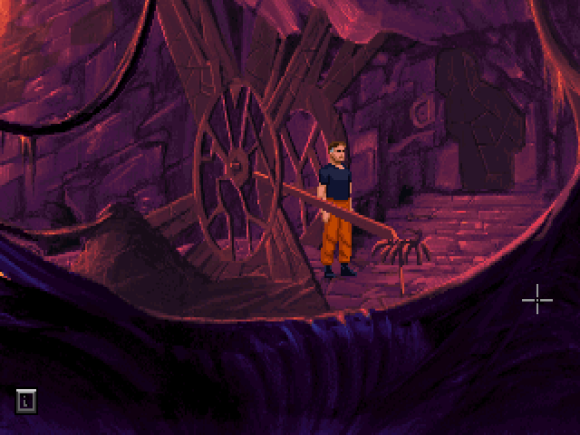
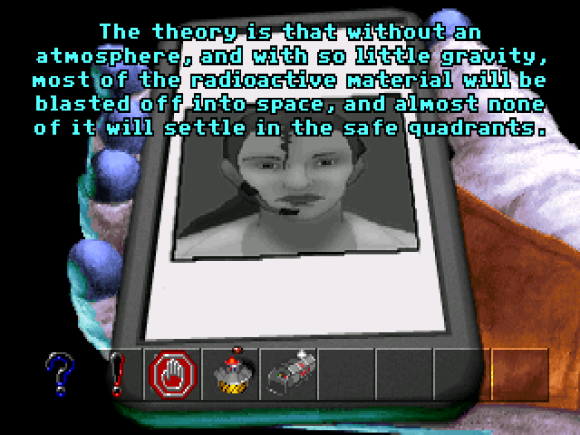
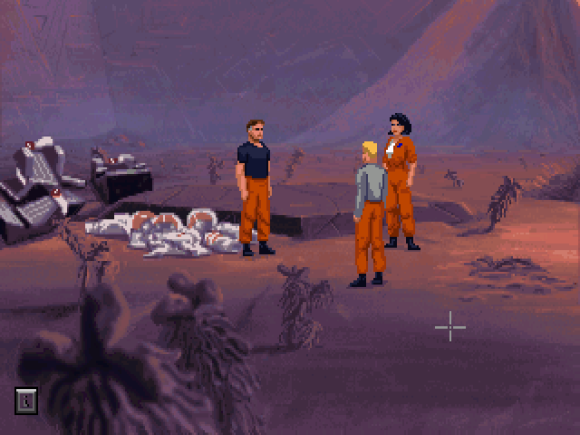
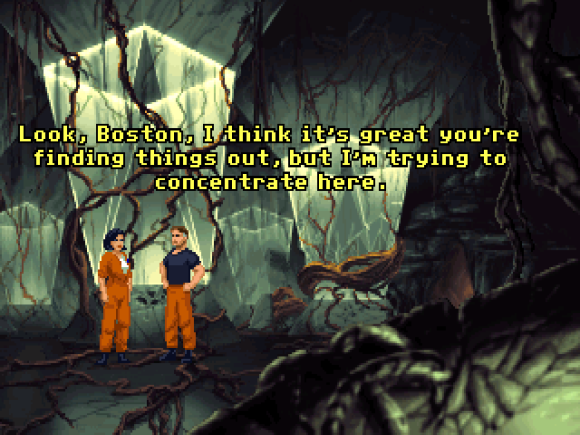
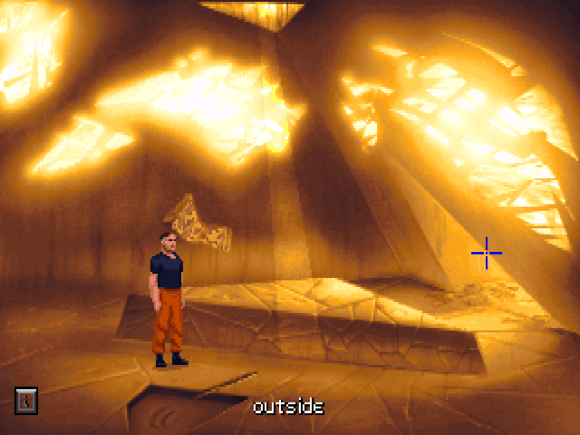
This has been a great series to read.
Thanks! Glad you’re enjoying it, and I hope to actually finish this one off soon.
Thanks, loving this series as well as all other articles
- how does it compare with Rama, if you’ve played it, which I think came plus or minus around same time? Seems like they’d cover similar thematic ground but different logistics
- given the context and my memories of Rama books, when I first read “you’re in command of Boston Low”, my mind read it as the team that was assigned to location termed Boston (after city) Low (presumably vs Boston High or Boston North). Took me a few sentences to recalibrate
I haven’t played Rama, no — it was one of those games that I was only peripherally aware of at the time via the ad pamphlets that came with other Sierra games, and I’d honestly forgotten all about it until you mentioned it. However I have read the books and the initial concepts of visiting an alien object in our Solar System and deciphering their secrets are *very* similar, to the point where I probably should have namedropped it in the post.
Glad you’re enjoying the series! And apologies for the slow reply, I’m not great at responding to feedback on here.
I’m also really enjoying this series, a genuine feeling of relief/excitement when I get the email telling me you posted, thank you.
Thanks! I am bad at responding to feedback, but it’s always nice to know that people are enjoying this stuff. I’ll probably do Curse in the next couple of weeks, and then maybe finish up with Grim Fandango if I can stand the tank controls.
On a complete tangent, I’ve always been fascinated with the design of futuristic PDAs in video games – particularly the way they always tended to look less advanced than actual real-life PDAs, presumably because it takes several years to develop a video game, so after a while the artwork lags behind reality.
But the PDA in The Dig is pretty much timeless. It seems to have been inspired by the wave of early-1990s stylus-and-LCD-screen tablets that were in vogue at the time, but it’s simple enough that it hasn’t aged. It even makes sense in context because NASA was hot for the latest tech gadgets.
I too remember the turtle puzzle. It’s sadistic. The interface implies that all the bones should go inside the shell, but they don’t. And there are two things that look like a skull, but one of them is actually the tail. And the thing that looks like a hip-bone actually *is* a hip-bone, but it doesn’t go where you’d expect, because where are a space turtle’s hips? Where are a space turtle’s hips?
Where are a space turtle’s hips? Where?